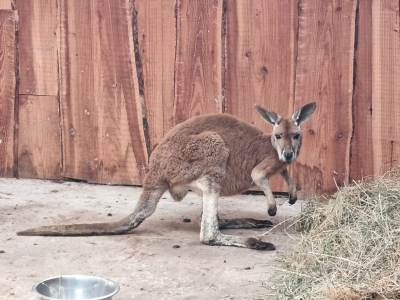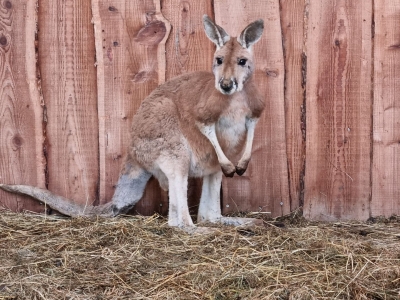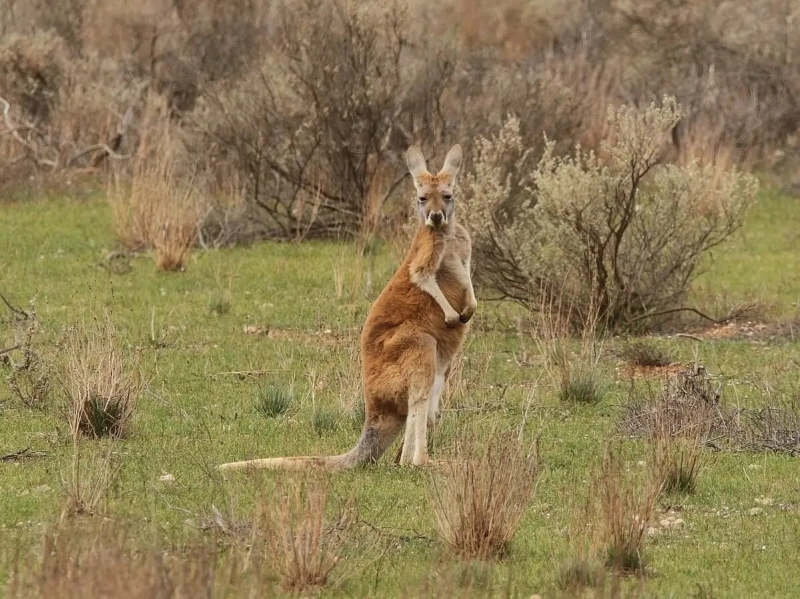Red kangaroo Osphranter rufus
Animals in our sanctuary
Bernard (Male)

Bernard, along with other animals, was illegally held by an individual. The animals were voluntary transferred to De Zonnegloed after an inspection by Animal Welfare Flanders, Belgium.
Fernand (Male)

Fernand, along with other animals, was illegally held by an individual. The animals were voluntary transferred to De Zonnegloed after an inspection by Animal Welfare Flanders, Belgium.
Where does he feel most at home?
The red kangaroo is found across mainland Australia, except for the more fertile areas, such as southern Western Australia, the eastern and southeastern coasts, and the rainforests along the northern coast.
The kangaroo ranges throughout western and central Australia. Its range encompasses scrubland, grassland, and desert habitats. It typically inhabits open habitats with some trees for shade.
What's his favourite food?
Red kangaroo primarily eat green vegetation, particularly fresh grasses and forbs, and can get enough even when most plants look brown and dry. One study of kangaroos in Central Australia found that green grass makes up 75 to 95% of the diet. Grazing takes up most of their daily activities.
Red kangaroos have a high tolerance for consuming plants high in salt content, and can survive for long periods without water by reabsorbing water from their urine in the kidneys, minimizing water loss. They can go for extended periods without drinking, meeting moisture requirements from consumed vegetation.
Fun fact
The red kangaroo is the largest of all kangaroos, the largest terrestrial mammal native to Australia. They have long, pointed ears and a square shaped muzzle (snout/nose). The males have short, red-brown fur, fading to pale buff below and on the limbs, while females are smaller than males and are blue-grey with a brown tinge and pale grey below, although arid zone females are coloured more like males. The animals have two forelimbs with small claws, two muscular hind-limbs, which are used for jumping, and a strong tail which is often used to create a tripod when standing upright. Males develop proportionately much larger shoulders and arms than females.
The red kangaroo maintains its internal temperature at a point of homeostasis about 36 °C (97 °F) using a variety of physical, physiological, and behavioural adaptations. These include having an insulating layer of fur, being less active and staying in the shade when temperatures are high, panting, sweating, and licking its forelimbs.
Like most kangaroo species, they are mostly sedentary, staying within a relatively well-defined home range. However, great environmental changes can cause them to travel great distances.
Red kangaroos live in groups of 2 to 4 members. The most common groups are females and their young. Larger groups can be found in densely populated areas and females are usually with a male. Membership of these groups is very flexible, and males (boomers) are not territorial, fighting only over females (flyers) that come into heat.
The red kangaroo breeds all year round. The females have the unusual ability to delay the birth of their baby until their previous joey has left the pouch. The red kangaroo has the typical reproductive system of a kangaroo. The neonate emerges after only 33 days. Usually only one young is born at a time. It is blind, hairless, and only a few centimetres long.
Conservation
The red kangaroo is an abundant species and has even benefited from the spread of agriculture and creation of man-made waterholes. However, competition with livestock and rabbits poses a threat. They are also sometimes shot by farmers as pests, although in Queensland and New South Wales a permit is required.
They have been evaluated and categorized by the International Union for Conservation of Nature (IUCN) as least-concern species.
Adopt this red kangaroo



